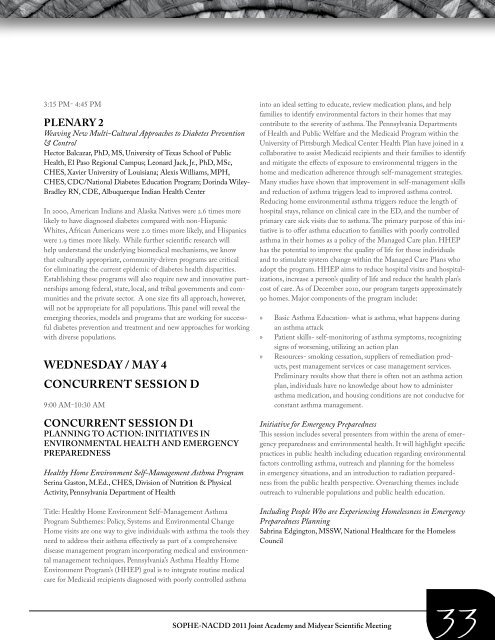to view the program - Society for Public Health Education
to view the program - Society for Public Health Education
to view the program - Society for Public Health Education
You also want an ePaper? Increase the reach of your titles
YUMPU automatically turns print PDFs into web optimized ePapers that Google loves.
3:15 PM- 4:45 PM<br />
Plenary 2<br />
Weaving New Multi-Cultural Approaches <strong>to</strong> Diabetes Prevention<br />
& Control<br />
Hec<strong>to</strong>r Balcazar, PhD, MS, University of Texas School of <strong>Public</strong><br />
<strong>Health</strong>, El Paso Regional Campus; Leonard Jack, Jr., PhD, MSc,<br />
CHES, Xavier University of Louisiana; Alexis Williams, MPH,<br />
CHES, CDC/National Diabetes <strong>Education</strong> Program; Dorinda Wiley-<br />
Bradley RN, CDE, Albuquerque Indian <strong>Health</strong> Center<br />
In 2000, American Indians and Alaska Natives were 2.6 times more<br />
likely <strong>to</strong> have diagnosed diabetes compared with non-Hispanic<br />
Whites, African Americans were 2.0 times more likely, and Hispanics<br />
were 1.9 times more likely. While fur<strong>the</strong>r scientific research will<br />
help understand <strong>the</strong> underlying biomedical mechanisms, we know<br />
that culturally appropriate, community-driven <strong>program</strong>s are critical<br />
<strong>for</strong> eliminating <strong>the</strong> current epidemic of diabetes health disparities.<br />
Establishing <strong>the</strong>se <strong>program</strong>s will also require new and innovative partnerships<br />
among federal, state, local, and tribal governments and communities<br />
and <strong>the</strong> private sec<strong>to</strong>r. A one size fits all approach, however,<br />
will not be appropriate <strong>for</strong> all populations. This panel will reveal <strong>the</strong><br />
emerging <strong>the</strong>ories, models and <strong>program</strong>s that are working <strong>for</strong> successful<br />
diabetes prevention and treatment and new approaches <strong>for</strong> working<br />
with diverse populations.<br />
WEDNESDAY / MAY 4<br />
Concurrent Session D<br />
9:00 AM-10:30 AM<br />
Concurrent Session D1<br />
Planning <strong>to</strong> Action: Initiatives in<br />
Environmental <strong>Health</strong> and Emergency<br />
Preparedness<br />
<strong>Health</strong>y Home Environment Self-Management Asthma Program<br />
Serina Gas<strong>to</strong>n, M.Ed., CHES, Division of Nutrition & Physical<br />
Activity, Pennsylvania Department of <strong>Health</strong><br />
in<strong>to</strong> an ideal setting <strong>to</strong> educate, re<strong>view</strong> medication plans, and help<br />
families <strong>to</strong> identify environmental fac<strong>to</strong>rs in <strong>the</strong>ir homes that may<br />
contribute <strong>to</strong> <strong>the</strong> severity of asthma. The Pennsylvania Departments<br />
of <strong>Health</strong> and <strong>Public</strong> Welfare and <strong>the</strong> Medicaid Program within <strong>the</strong><br />
University of Pittsburgh Medical Center <strong>Health</strong> Plan have joined in a<br />
collaborative <strong>to</strong> assist Medicaid recipients and <strong>the</strong>ir families <strong>to</strong> identify<br />
and mitigate <strong>the</strong> effects of exposure <strong>to</strong> environmental triggers in <strong>the</strong><br />
home and medication adherence through self-management strategies.<br />
Many studies have shown that improvement in self-management skills<br />
and reduction of asthma triggers lead <strong>to</strong> improved asthma control.<br />
Reducing home environmental asthma triggers reduce <strong>the</strong> length of<br />
hospital stays, reliance on clinical care in <strong>the</strong> ED, and <strong>the</strong> number of<br />
primary care sick visits due <strong>to</strong> asthma. The primary purpose of this initiative<br />
is <strong>to</strong> offer asthma education <strong>to</strong> families with poorly controlled<br />
asthma in <strong>the</strong>ir homes as a policy of <strong>the</strong> Managed Care plan. HHEP<br />
has <strong>the</strong> potential <strong>to</strong> improve <strong>the</strong> quality of life <strong>for</strong> those individuals<br />
and <strong>to</strong> stimulate system change within <strong>the</strong> Managed Care Plans who<br />
adopt <strong>the</strong> <strong>program</strong>. HHEP aims <strong>to</strong> reduce hospital visits and hospitalizations,<br />
increase a person’s quality of life and reduce <strong>the</strong> health plan’s<br />
cost of care. As of December 2010, our <strong>program</strong> targets approximately<br />
90 homes. Major components of <strong>the</strong> <strong>program</strong> include:<br />
»»<br />
Basic Asthma <strong>Education</strong>- what is asthma, what happens during<br />
an asthma attack<br />
»»<br />
Patient skills- self-moni<strong>to</strong>ring of asthma symp<strong>to</strong>ms, recognizing<br />
signs of worsening, utilizing an action plan<br />
»»<br />
Resources- smoking cessation, suppliers of remediation products,<br />
pest management services or case management services.<br />
Preliminary results show that <strong>the</strong>re is often not an asthma action<br />
plan, individuals have no knowledge about how <strong>to</strong> administer<br />
asthma medication, and housing conditions are not conducive <strong>for</strong><br />
constant asthma management.<br />
Initiative <strong>for</strong> Emergency Preparedness<br />
This session includes several presenters from within <strong>the</strong> arena of emergency<br />
preparedness and environmental health. It will highlight specific<br />
practices in public health including education regarding environmental<br />
fac<strong>to</strong>rs controlling asthma, outreach and planning <strong>for</strong> <strong>the</strong> homeless<br />
in emergency situations, and an introduction <strong>to</strong> radiation preparedness<br />
from <strong>the</strong> public health perspective. Overarching <strong>the</strong>mes include<br />
outreach <strong>to</strong> vulnerable populations and public health education.<br />
Title: <strong>Health</strong>y Home Environment Self–Management Asthma<br />
Program Sub<strong>the</strong>mes: Policy, Systems and Environmental Change<br />
Home visits are one way <strong>to</strong> give individuals with asthma <strong>the</strong> <strong>to</strong>ols <strong>the</strong>y<br />
need <strong>to</strong> address <strong>the</strong>ir asthma effectively as part of a comprehensive<br />
disease management <strong>program</strong> incorporating medical and environmental<br />
management techniques. Pennsylvania’s Asthma <strong>Health</strong>y Home<br />
Environment Program’s (HHEP) goal is <strong>to</strong> integrate routine medical<br />
care <strong>for</strong> Medicaid recipients diagnosed with poorly controlled asthma<br />
Including People Who are Experiencing Homelessness in Emergency<br />
Preparedness Planning<br />
Sabrina Edging<strong>to</strong>n, MSSW, National <strong>Health</strong>care <strong>for</strong> <strong>the</strong> Homeless<br />
Council<br />
SOPHE-NACDD 2011 Joint Academy and Midyear Scientific Meeting 33

















